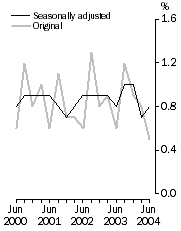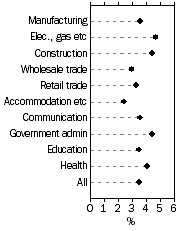JUNE KEY FIGURES
Quarterly changes

| Annual change: original, For selected industries

|
JUNE KEY POINTS
INDEXES OF TOTAL HOURLY RATES OF PAY EXCLUDING BONUSES
QUARTERLY CHANGES (MAR QTR 2004 TO JUN QTR 2004)
- The index for all employee jobs in Australia increased by 0.8%, seasonally adjusted.
- The increases in the indexes (in original terms) at the industry level ranged from 0.1% for Accommodation, cafes and restaurants, Communication services, and Personal and other services to 1.4% for Construction.
- The increase in the indexes (in original terms) at the occupation level ranged from 0.2% for Elementary clerical, sales and service workers to 0.7% for Tradespersons and related workers, Advanced clerical and service workers, and Intermediate production and transport workers.
ANNUAL CHANGES (JUN QTR 2003 TO JUN QTR 2004)
- The seasonally adjusted increase through the year to June 2004 for all employee jobs in Australia was 3.6% (in trend terms, 3.5%).
- Increases in the original indexes through the year to June 2004 at the industry level ranged from 2.4% for Accommodation, cafes and restaurants to 4.7% for Electricity, gas and water supply.
NOTES
ABS DATA AVAILABLE ON REQUEST
Original indexes are compiled for various combinations of state/territory, sector (private/public), broad industry group and broad occupation group. Seasonally adjusted and trend indexes are only compiled for total hourly rates of pay excluding bonuses for the private sector, public sector and all sectors. Indexes not included in this publication may be made available on request by telephoning Perth (08) 9360 5151.
CHANGES IN NEXT ISSUE
Indexes of non-wage costs will be released for the first time in the September quarter 2004 publication. As a result, the Wage Cost Index, Australia publication will be renamed Labour Price Index, Australia (LPI) from September quarter 2004. The name change provides clearer links between the survey and the data produced, and is appropriate given the inclusion of non-wage indexes each year.
The LPI will comprise wage and salary costs (i.e. the existing "wage cost index") as well as non-wage components such as superannuation and annual leave. The wage cost components of the LPI are collected and published quarterly and have been since September 1997. The LPI, comprising both wage and non-wage components will be published annually, from the 2001-02 financial year on. The wage cost index will continue to be published quarterly, and it will remain the "headline measure" of changes in wage costs. The layout of the front page of the publication will remain the same.
An Information Paper setting out the content of the non-wage cost index and the methods used in constructing it will be released around the beginning of November 2004.
FURTHER INFORMATION
More detailed information on the Wage Cost Index is available in Information Paper: Wage Cost Index, Australia, 2000 (cat. no. 6346.0).
INQUIRIES
For further information about these and related statistics, contact the National Information and Referral Service on 1300 135 070 or Tim Landrigan on Perth (08) 9360 5151.
COMMENTARY
OVERALL
Victoria made the largest contribution of all states and territories to the original Australian WCI increase in June quarter 2004. A major contributor to the Victorian increase was the move from a 38-hour to a 36-hour week in the Construction industry, effective from 1 March 2004.
Pay increases in the Manufacturing industry were significant in New South Wales, Victoria, Queensland, South Australia and Tasmania.
PRIVATE SECTOR
The Private sector seasonally adjusted movement through the year to June quarter 2004 was 3.4%, which is the same as the increase through the year to March quarter 2004. The seasonally adjusted movement for the June quarter 2004 of 0.8% was the same as for the previous quarter.
PUBLIC SECTOR
The seasonally adjusted movement through the year to June quarter 2004 of 4.0% is a decrease on the movements through the year to March quarter 2004 and to December quarter 2003, which were 4.3% and 4.9% respectively.
In the original series, the Australian public sector increase on the previous quarter was 0.2%. The only states and territories to report movements other than 0.2% were Western Australia (0.5%), Tasmania (0.7%) and the Northern Territory (0.7%).
The new Public Service General Agreement in Western Australia was finalised in late July and the increase of 3.8% will flow into the September quarter 2004 WCI.
SAFETY NET REVIEW (SNR)
The Australian Industrial Relations Commission handed down its 2004 SNR decision on 5 May 2004. It awarded a $19 a week increase to workers employed under federal awards. The 2004 SNR decision has had little effect on the June quarter WCI figures since the reference date for the survey was the pay period ending on or before 16 May 2004. The flow-on into the WCI is expected to occur primarily in the September and December quarters 2004.
INFLUENCES ON THE WCI
Pay movements in the Private sector in June quarter 2004 were dominated by certified agreements and salary reviews, with a small number of jobs being affected by award-based increases. Certified agreements were almost entirely responsible for the Public sector pay increases in June quarter 2004.
 Print Page
Print Page
 Print All
Print All